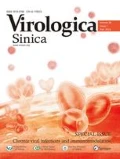Abstract
The cellular protein tetherin tethers the HIV-1 viral particles on the cellular membrane to inhibit the replication of HIV-1. However, the HIV-1 accessory protein Vpu counteracts the antiviral function of tetherin. In this study, two retroviral vector plasmids were constructed. One inhibited the vpu gene expression; the other one over-expressed the tetherin. Both retroviral vector plasmids could be packaged in the packaging cell line PT67 to obtain the corresponding retroviruses. The retroviral vector plasmids’ functions of tetherin over-expression or vpu-RNAi were detected at the cell level. Retroviral vector plasmids were transfected to PT67 cells at different ratios from 0T3V to 3T0V, and then mixed retroviruses were harvested. The antiviral functions of mixed retroviruses were detected in HIV-1 infected TZM-bl cells. The results showed that packaged mixed retroviruses could repress the replication of HIV-1 in TZM-bl cells.
Similar content being viewed by others
References
Andrew A J, Miyagi E, Strebel K. 2010. Differential effects of human immunodeficiency virus type 1 vpu on the stability of bst-2/tetherin. J Virol, 85(6): 2611–2619.
Douglas J L, Viswanathan K, McCarroll M N, et al. 2009. Vpu directs the degradation of the human immunodeficiency virus restriction factor bst-2/tetherin via a tatrcp-dependent mechanism. J Virol, 83(16): 7931–7947.
Goto T, Kennel S J, Abe M, et al. 1994. A novel membrane antigen selectively expressed on terminally differentiated human b cells. Blood, 84(6): 1922–1930.
Gupta R K, Mlcochova P, Pelchen-Matthews A, et al. 2009. Simian immunodeficiency virus envelope glycoprotein counteracts tetherin/bst-2/cd317 by intracellular sequestration. Proc Natl Acad Sci U S A, 106(49): 20889–20894.
Hauser H, Lopez L A, Yang S J, et al. 2010. Hiv-1 vpu and hiv-2 env counteract bst-2/tetherin by sequestration in a perinuclear compartment. Retrovirology, 7: 51.
Ishikawa J, Kaisho T, Tomizawa H, et al. 1995. Molecular cloning and chromosomal mapping of a bone marrow stromal cell surface gene, bst2, that may be involved in pre-b-cell growth. Genomics, 26(3): 527–534.
Klimkait T, Strebel K, Hoggan M D, et al. 1990. The human immunodeficiency virus type 1-specific protein vpu is required for efficient virus maturation and release. J Virol, 64(2): 621–629.
Kong X, West J T, Zhang H, et al. 2008. The human immunodeficiency virus type 1 envelope confers higher rates of replicative fitness to perinatally transmitted viruses than to nontransmitted viruses. J Virol, 82(23): 11609–11618.
Kupzig S, Korolchuk V, Rollason R, et al. 2003. Bst-2/hm1.24 is a raft-associated apical membrane protein with an unusual topology. Traffic, 4(10): 694–709.
Le Tortorec A, Willey S, Neil S J. 2011. Antiviral inhibition of enveloped virus release by tetherin/bst-2: Action and counteraction. Viruses, 3(5): 520–540.
Liu C, Shi Y J, Xuan C h, et al. 2008. Establishment of an in vitro protein modification system with antiserum against ubiquitin-like modifier bisg15. Chin J Biochem Mol Biol, 24(1): 30–34. (in Chinese)
Liu C, Chang R, Yao X, et al. 2009. Isg15 expression in response to double-stranded rna or lps in cultured fetal bovine lung (fbl) cells. Vet Res Commun, 33(7): 723–733.
Malim M H, Emerman M. 2008. HIV-1 accessory proteins—ensuring viral survival in a hostile environment. Cell Host Microb, 3(6): 388–398.
Miller A D, Chen F. 1996. Retrovirus packaging cells based on 10a1 murine leukemia virus for production of vectors that use multiple receptors for cell entry. J Virol, 70(8): 5564–5571.
Naito Y, Ui-Tei K, Nishikawa T, et al. 2006. Sivirus: Web-based antiviral sirna design software for highly divergent viral sequences. Nucleic Acids Res, 34(Web Server issue): W448–450.
Neil S J, Zang T, Bieniasz P D. 2008. Tetherin inhibits retrovirus release and is antagonized by hiv-1 vpu. Nature, 451(7177): 425–430.
Nguyen D H, Hildreth J E. 2000. Evidence for budding of human immunodeficiency virus type 1 selectively from glycolipid-enriched membrane lipid rafts. J Virol, 74(7): 3264–3272.
Platt E J, Bilska M, Kozak S L, et al. 2009. Evidence that ecotropic murine leukemia virus contamination in tzm-bl cells does not affect the outcome of neutralizing antibody assays with human immunodeficiency virus type 1. J Virol, 83(16): 8289–8292.
Reinke S O, Bayer M, Berger M, et al. 2011. Analysis of cell surface n-glycosylation of the human embryonic kidney 293t cell line. J Carbohydr Chem, 30(4–6): 218–232.
Salmon P, Trono D. 2006. Design and production of human immunodeficiency virus-derived vectors, In: Cell biology: A laboratory handbook. Celis J E, ed., Third Edition: Elsevier Inc. Volume 1, pp 425–434.
Skasko M, Wang Y, Tian Y, et al. 2011. HIV-1 vpu protein antagonizes innate restriction factor bst-2 via lipid-embedded helix-helix interactions. J Biol Chem, 287(1): 58–67.
Terwilliger E F, Cohen E A, Lu Y C, et al. 1989. Functional role of human immunodeficiency virus type 1 vpu. Proc Natl Acad Sci U S A, 86(13): 5163–5167.
Tokarev A, Skasko M, Fitzpatrick K, et al. 2009. Antiviral activity of the interferon-induced cellular protein bst-2/tetherin. AIDS Res Hum Retroviruses, 25(12): 1197–1210.
Van Damme N, Goff D, Katsura C, et al. 2008. The interferon-induced protein bst-2 restricts hiv-1 release and is downregulated from the cell surface by the viral vpu protein. Cell Host Microbe, 3(4): 245–252.
Author information
Authors and Affiliations
Corresponding authors
Additional information
Foundation items: National Natural Science Foundation of China (81101245, 30970162); The Fundamental Research Funds for the Central Universities (65011871); National Training Programs of Innovation for Undergraduates (111005505).
Rights and permissions
About this article
Cite this article
Liang, Z., Guo, Z., Wang, X. et al. Two retroviruses packaged in one cell line can combined inhibit the replication of HIV-1 in TZM-bl cells. Virol. Sin. 27, 338–343 (2012). https://doi.org/10.1007/s12250-012-3263-8
Received:
Accepted:
Published:
Issue Date:
DOI: https://doi.org/10.1007/s12250-012-3263-8




